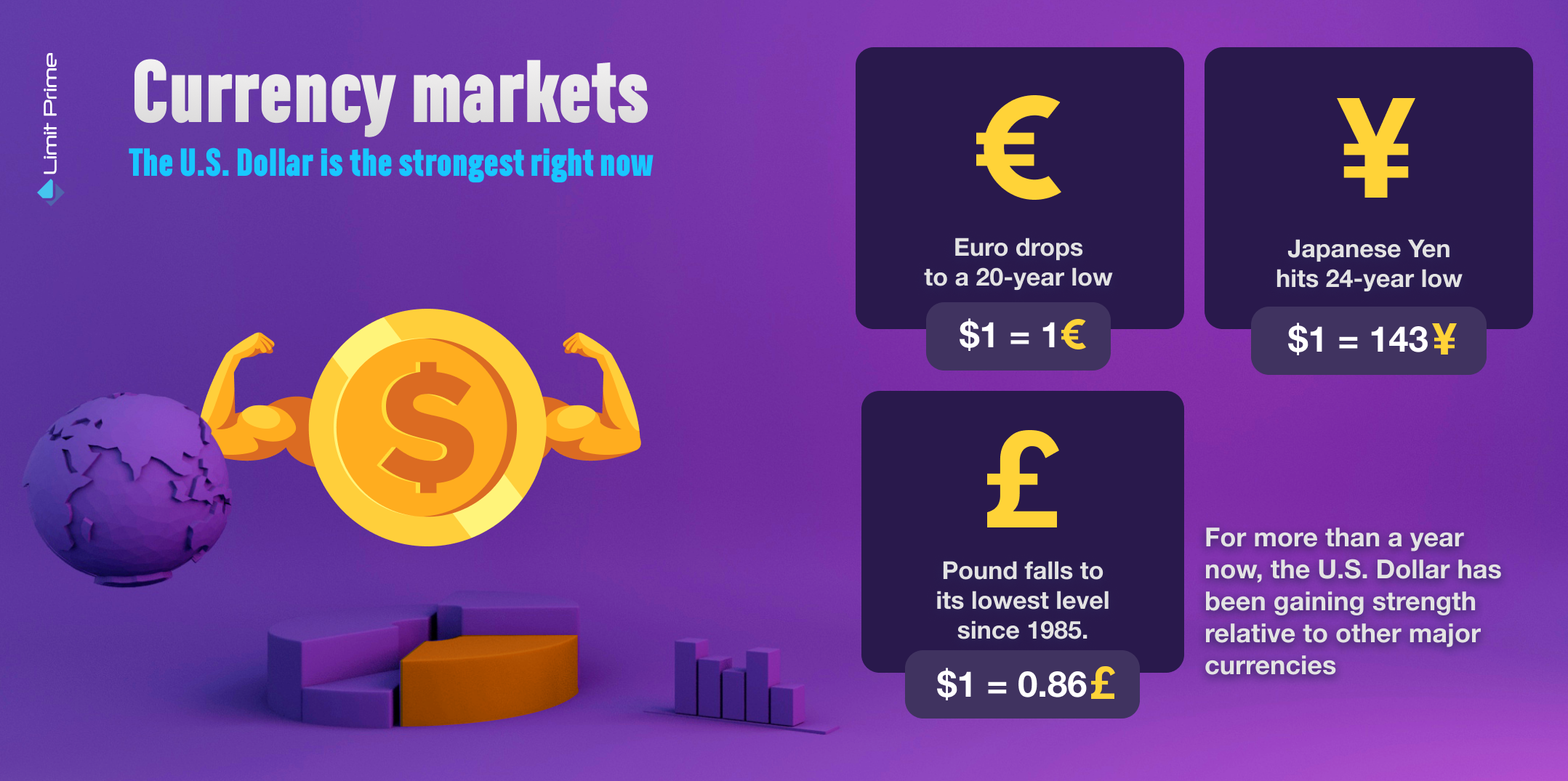Currency market - Why is the U.S. dollar so strong right now?
15.09.2022

Euro drops to a 20-year low, falling below a dollar! The pound has plummeted to its lowest level against the US dollar since 1985! Japanese yen hits a 24-year low against the dollar! Resilient U.S. dollar soars to 24-year high vs yen, 37-year peak vs sterling! Yuan heads for a record yearly fall against the dollar.
Lately, these are the headlines we’ve been surrounded with when it comes to the currency market.
For more than a year now, the U.S. dollar has gradually gained strength relative to other major global currencies, like the euro, yen, British pound, yuan, and Canadian dollar.
The most important force driving the dollar up against other major currencies is U.S. monetary policy.
In the face of tightening global financial conditions—led by the US Federal Reserve—most investors are pouring into short-term Treasuries, pushing up the price of the dollar relative to other currencies. Raising rates also means investors can get a higher return if they park their money in US assets. That has pushed the dollar up to a 20-year high.
Not only has the Federal Reserve been raising U.S. interest rates aggressively to wrestle down inflation, but Fed Chair Jerome Powell has pledged he won’t stop until he wins.
The dollar is performing strongly due to US interest rate rises and because investors see it as a safer bet. There’s a strong tendency for the dollar to strengthen whenever the global economy is in some sort of crisis. And so, as markets panic, investors flee to safety, the dollar appreciates. The dollar’s persistent strength also tells us something about the U.S. economy’s prospects, especially compared to Europe’s, which is in the midst of war and already likely in recession. The Fed is probably the most influential central bank in the globe, as determined as any right now in order to tame down domestic inflation. And so as U.S. interest rates rise, capital flows into the country, pushing up the price of the dollar.
Yes, the dollar has been rising in large part because the Federal Reserve is on track to increase interest rates faster than other major countries. As the growth outlook for the world economy worsens, investors have grown more concerned and flocked to the dollar, putting their money into safer assets like US Treasury bonds. That in turn has pushed up the currency’s value.
More recently, it has less to do with the U.S. and more to do with a global downturn.
The basic explanation for the strong dollar comes down to this: While things might be weird in the US economy right now, a combination of factors has made the dollar a better bet for investors than most other currencies.
What does this mean for Americans?
For Americans, the strong dollar makes it a good time to travel to Europe, with the exchange rate giving U.S. tourists greater purchasing power. Americans traveling outside the US will find that they are about 14% richer than they were at the beginning of the year. That’s because the dollar has risen that much against some of the world’s most traded currencies. are already finding it easier to fund European vacations and purchase luxury goods and fine wines in other countries. Some American buyers are even house hunting in countries like France since the weaker euro means it’s cheaper for them to buy real estate in Europe compared to a year ago.
Among other things, a stronger dollar helps curb inflation by making imports cheaper. Foreign sellers are more inclined to drop prices when the dollar becomes more valuable, which translates to lower prices for imported products that Americans buy.
Although a strong dollar is mostly favorable for American consumers, it can have more negative impacts on companies that operate businesses in other countries because revenue and profits earned in local currencies are worth less in dollar terms and their products become more expensive abroad, reducing demand.
For example, profits at both Microsoft and Nike, for example, have recently eroded. Apple generates more than 60 percent of its sales outside the United States; it and other tech giants, which dominate many stock indexes, are likely to suffer from the dollar’s strength when they reveal their latest financial results in the coming weeks.
Exports also become more expensive abroad, which could hurt American companies that export goods or services. Workers in industries like agriculture or manufacturing could also be impacted if their jobs depend on exports.
Overall, though, many Americans might not notice the effects of a stronger dollar in their daily lives, because compared to many European countries, the United States is more self-sufficient, producing much of what Americans consume.
A stronger dollar can make real estate in the United States more expensive for foreign buyers, making those investments less attractive to them. That could help relieve some price pressures in the housing market, a positive outcome for Americans trying to buy homes. But generally, people in other countries are more likely to feel the impact of a stronger dollar than Americans.
While a stronger dollar can be a mixed blessing for people and companies, such a sharp, quick move in the value of the world’s most widely used currency can have a destabilizing effect of its own.
What does this mean for other countries?
The dollar’s rise also has a lot to do with what’s going on in the rest of the world, not only in the U.S.
Europe is facing an energy crisis, and it’s getting worse and worse almost every day. Russia’s invasion of Ukraine has also strained European economies and made natural gas prices skyrocket, making the US economy look healthier in comparison to the Eurozone.
Analysts said the fall reflects the darkening outlook for the economy, with consumers and businesses facing rising prices and soaring energy bills.
Also, they said the dollar was rising because high energy prices were hitting the economies of importers, including most of Europe, harder than the United States, which is less reliant on buying oil and gas from abroad.
Companies based outside the United States have seen their sales bolstered by the strong dollar. Burberry, the British luxury goods maker, said on Friday that it would add more than $200 million to its revenue this year because of movements in the currency — helping to offset a decline in sales in China, where the economy is slowing.
For other countries, a strong dollar pushes import prices up, which can create inflation in those regions. The impact can also be brutal for emerging economies.
When US interest rates are low, global investors tend to invest more in emerging markets, or the economies of nations that are transitioning into developed economies. But when rates start to rise in the United States and the dollar climbs, money starts to flow out of those countries.
Many companies and governments abroad borrow in dollars, and the currency’s strength is a big problem. This is particularly true for poorer countries attracted to dollar-denominated debt as an alternative to less developed local markets.
Likely to be most affected are those countries where dollar debt represents a large portion of their gross domestic product. Paying interest to creditors in dollars has become particularly difficult for countries with rapidly depreciating currencies like Argentina and Turkey, especially as interest rates on any new debt will also go up. In some cases, including Sri Lanka, it has become seemingly impossible.
Some developing nations are better equipped to handle this since they have more reserves or their exports are priced in dollars and have been rising in value, but other countries could struggle. Sri Lanka’s economy, for example, is starting to crumble as it deals with a mountain of debt and not enough US dollars to pay for imports of essential goods.
Countries that borrow heavily in dollars could suffer because it becomes harder to make repayments as the dollar rises and their currencies depreciate.
That means the number of dollars they need to get their hands on to make repayments goes up.
How are countries fighting back?
The stronger dollar has prompted more rate hikes around the world as central bankers try to increase the value of their own currencies. Over the past few months, several countries have been increasing the pace of their hikes, with rates in some places now exceeding 10%. But raising rates in parts of the world where currencies are being devalued also raises recession risks. The Fed can probably get away with raising rates, because the U.S. economy is relatively stable, given the strong labor market. But other economies, including the eurozone, don’t have that cushion.
Where does the dollar go from here?
The value of the U.S. dollar is the strongest it has been in a generation, devaluing currencies around the world and unsettling the outlook for the global economy as it upends everything from the cost of a vacation abroad to the profitability of multinational companies.
Currency markets are extremely hard to predict, so it’s difficult to say whether the dollar will continue to climb or fall in the coming months. According to the analysts, the dollar could drop only if the war in Ukraine miraculously stopped, relieving pressure on European economies and pushing up their currencies.
The dollar could also fall if the US enters a recession and the Fed has to cut interest rates to stimulate the economy, which some analysts predict could happen next year. An economic downturn in the United States could also make investing in US assets and companies look less attractive, which could result in the dollar falling.
On the other hand, if inflation stays stubbornly high and the Fed has to keep raising interest rates more than expected, the dollar could keep rising. It could also climb if the European Central Bank, which raised interest rates for the first time in more than a decade last week, has to backpedal and cut rates.
It’s a very uncertain environment, and the exchange rate probably is hard to predict with certainty.
The main way to gauge the dollar’s strength is by indexing it against a basket of currencies of major trading partners like Japan and the eurozone. By that measure, the dollar is at a 20-year high, after gaining more than 10 percent this year, a huge move for an index that typically shifts by tiny fractions each day.
Keeping in mind that the global political and economic situation is not likely to make big shifts soon, the U.S. dollar has a big chance of keeping on the throne for the upcoming period as well.
The currency has been stronger on only three occasions since the 1960s. This could be a good moment to position yourself wisely in the currency market.
LimitPrime © 2025
Categories
Leave comment
Comments
READ MORE INTERESTING ARTICLES

In today's chip-making world, there's a new kid on the block: artificial intelligence (AI). Several companies are changing the...
Read More
What is Bitcoin Halving?Bitcoin halving day is eagerly anticipated by crypto enthusiasts and investors, and of course, it marks a cruci...
Read More
In the evolving world of cryptocurrency, where Bitcoin and Ethereum often take center stage, there isn't much focus on the other di...
Read More